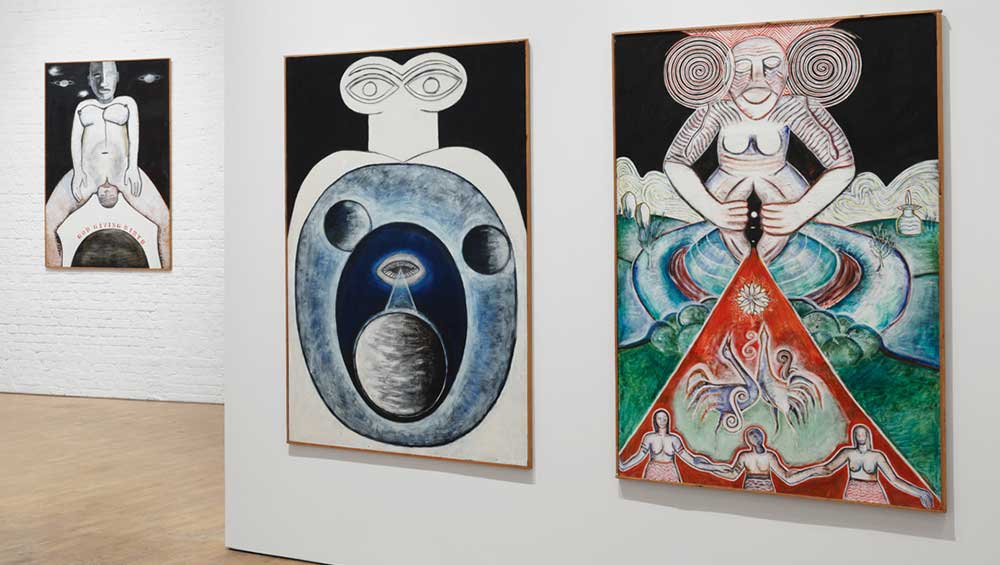
Monica Sjöö: The Great Cosmic Mother, installation view, Modern Art Oxford, 18 November 2023 – 25 February 2024.
Modern Art Oxford
18 November 2023 – 25 February 2024
by BETH WILLIAMSON
This exhibition, the first major retrospective of work by the Swedish artist Monica Sjöö (1938-2005), presents more than 50 works from her 40-year-long career from the 1960s to the 2000s. The exhibition has already been shown at Moderna Museet in Stockholm where the climate activist Greta Thunberg was photographed visiting. Now it is in Oxford, around 70 miles from Sjöö’s adopted home of Bristol. Sjöö left Sweden in 1955, aged 17. After travelling and living in various European cities, she moved to Bristol where her then-husband’s family lived. It was there she built her career and raised her family. Sjöö devoted her life to advocacy for gender justice, eco-feminism, matriarchy and social equality. As an artist, activist and writer, politics and spirituality were embedded in her artistic practice and throughout her career, she demonstrated a deep and enduring commitment to women’s rights and environmentalism, fighting for freedom from oppression in all its forms.
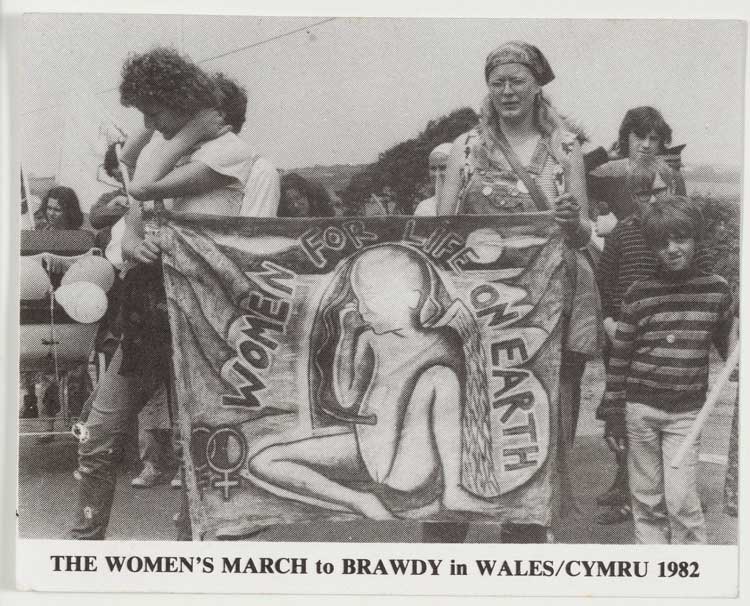
Monica Sjöö depicted on a postcard from the Women for Life on Earth Peace March, 1982. © The Estate of Monica Sjöö.
The body of work on show in this exhibition is astonishing. The focus is on large-scale paintings, but it also includes posters, banners, publications and archive material, all of which lends it a breadth and depth despite its very clear focus. A committed eco-feminist, Sjöö was also a strongly spiritual person who was engaged with the Goddess movement and often visited and painted ancient sites of significance close to her Bristol home. She was active in feminist organisations in the UK, campaigning for everything from the plight of housewives to women’s reproductive rights. Women’s reproductive rights are again an urgent topic following the US supreme court’s overturning of Roe v Wade in 2022, removing a constitutional right to abortion that had been in place for half a century.
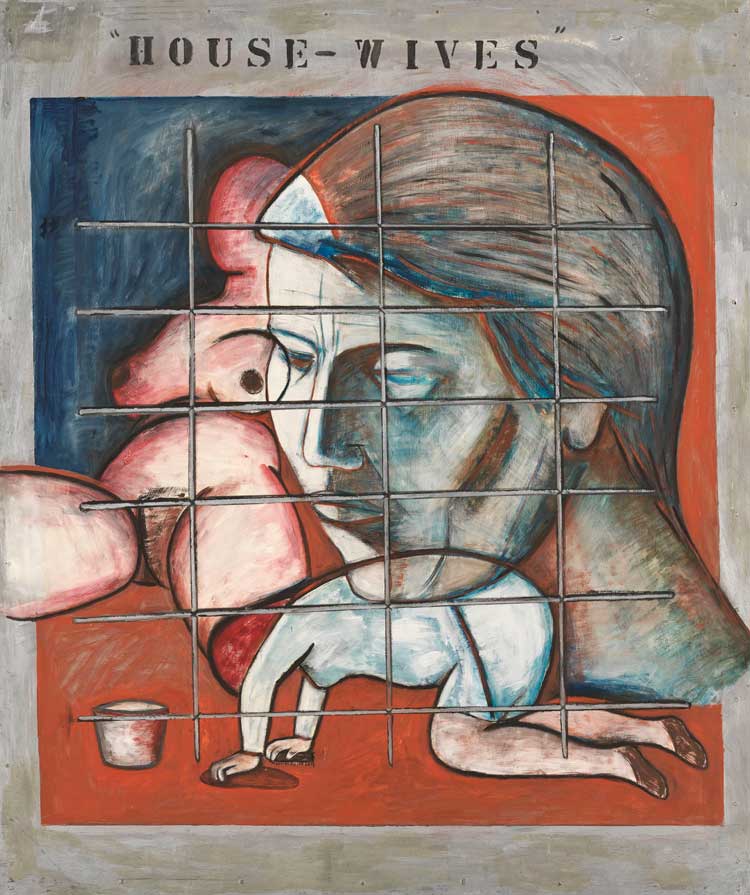
Monica Sjöö, House-Wives, 1975. Courtesy Monica Sjöö Estate and Alison Jacques, London. © Monica Sjöö Estate.
Housewives of Sjöö’s era were often trapped in traditional gender roles, something she addresses in her painting House-Wives (1975) with a trio of figures comprising an eroticised woman, a woman cleaning and an idealised woman. She participated in the grassroots Wages for Housework collective, formed in the 1970s, whose chant on protest marches was: “Tremble, tremble, the witches are returning – not to be burned but to be paid.” Motivated to end patriarchy, Sjöö looked to different cultures and histories. Thinking back to ancient matriarchal cultures, her politics came from a place of universal kinship.
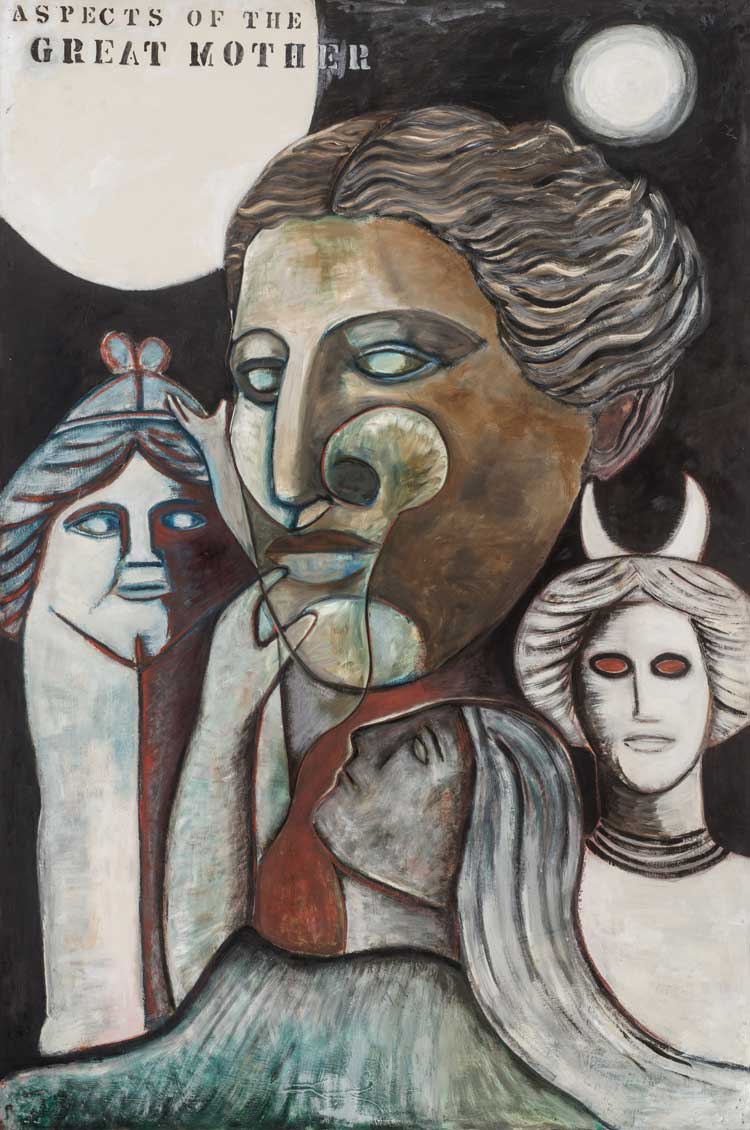
Monica Sjöö, Aspects of the Great Mother, 1971. Courtesy Monica Sjöö Estate and Alison Jacques, London. © Monica Sjöö Estate.
At the heart of everything for Sjöö, and closely entwined with her ecological concerns, was the Goddess movement and the Great Cosmic Mother. Sjöö had an alienating experience giving birth to first son in hospital, followed by something akin to a spiritual experience giving birth to her second son at home. This physical and cosmic experience caused Sjöö to recognise the Goddess and her energy, the creative powers of the Great Mother and all mothers. As a result of this transformative experience, she viewed motherhood in a religious light and painted God Giving Birth (1968), a work that courted controversy. Other goddess works from the 70s in this show include Aspects of the Great Mother (1971) and Sheela na Gig, Creation (1978).
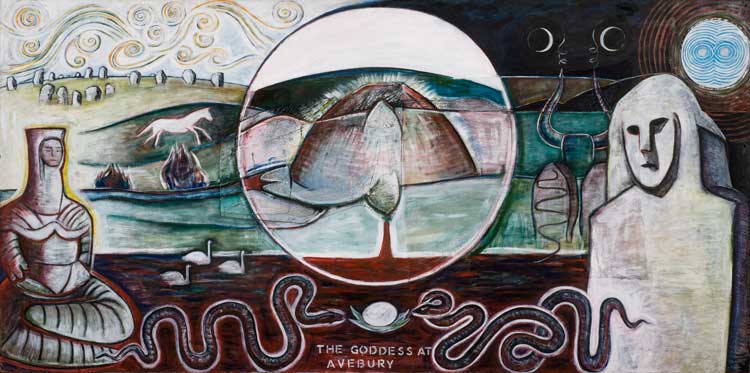
Monica Sjöö, The Goddess at Avebury & Silbury, 1978. Courtesy Monica Sjöö Estate and Alison Jacques, London. © Monica Sjöö Estate.
By this time, Sjöö’s focus had shifted away from gender equality to an ecological fight for life and against patriarchal structures. Eco-feminism emerges more strongly in The Goddess at Avebury and Silbury (1978). Although Sjöö found the ancient site at Stonehenge too phallic, those at Avebury and Silbury appealed to her. She was politically motivated to locate and visit such sites and to live differently. She made pilgrimages and returned repeatedly to sites that were important to her. Sjöö’s eco-feminism found new form through her engagement with the Campaign for Nuclear Disarmament (CND) and the Greenham Common Women’s Peace Camp. Much of this activism is represented in the exhibition by facsimile reproductions of posters, shown effectively and en masse with archival photographs and postcards.
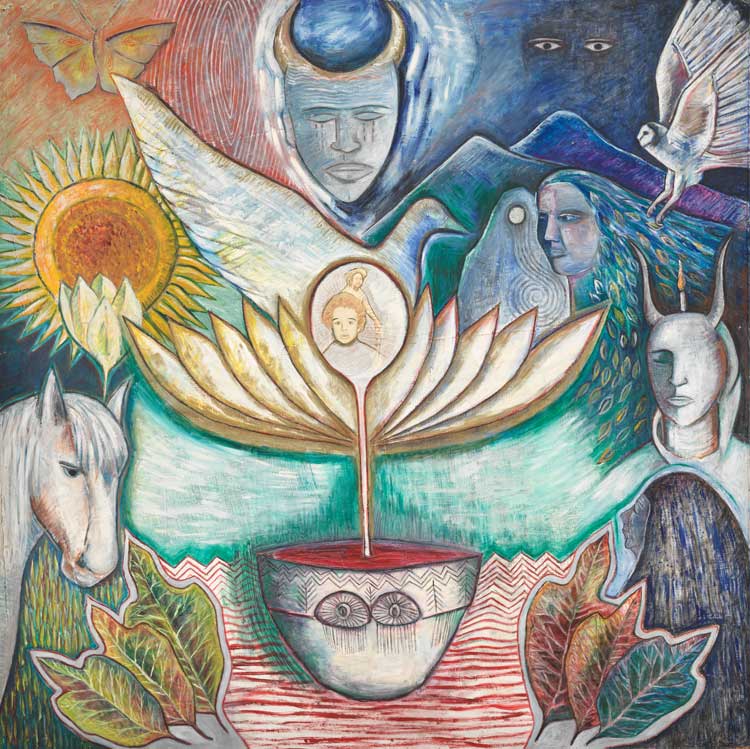
Monica Sjöö, Rebirth from the Motherpot, 1987. Courtesy Monica Sjöö Estate and Alison Jacques, London. © Monica Sjöö Estate.
As an artist, Sjöö had never felt included in the wider art world and often exhibited her work with alternative feminist and political communities alongside talks and lectures that were tied to the work so that the politics were always visible. From the late 80s onwards, Sjöö became more distant from the art world. The death of two of her three sons in that period was a deep personal tragedy that left her unable to paint for a time. One of the few works she made then was the celestial Rebirth from the Motherpot (1987). Her book The Great Cosmic Mother: Rediscovering the Religion of the Earth, co-authored with the American poet and writer Barbara Mor (1936-2015) was published the same year. Challenging what a feminist political practice might look like, Sjöö continued to connect to ancient sacred sites and was drawn to tomb- or womb-like spaces. At the same time, she still campaigned against patriarchy and protested for women and the environment.
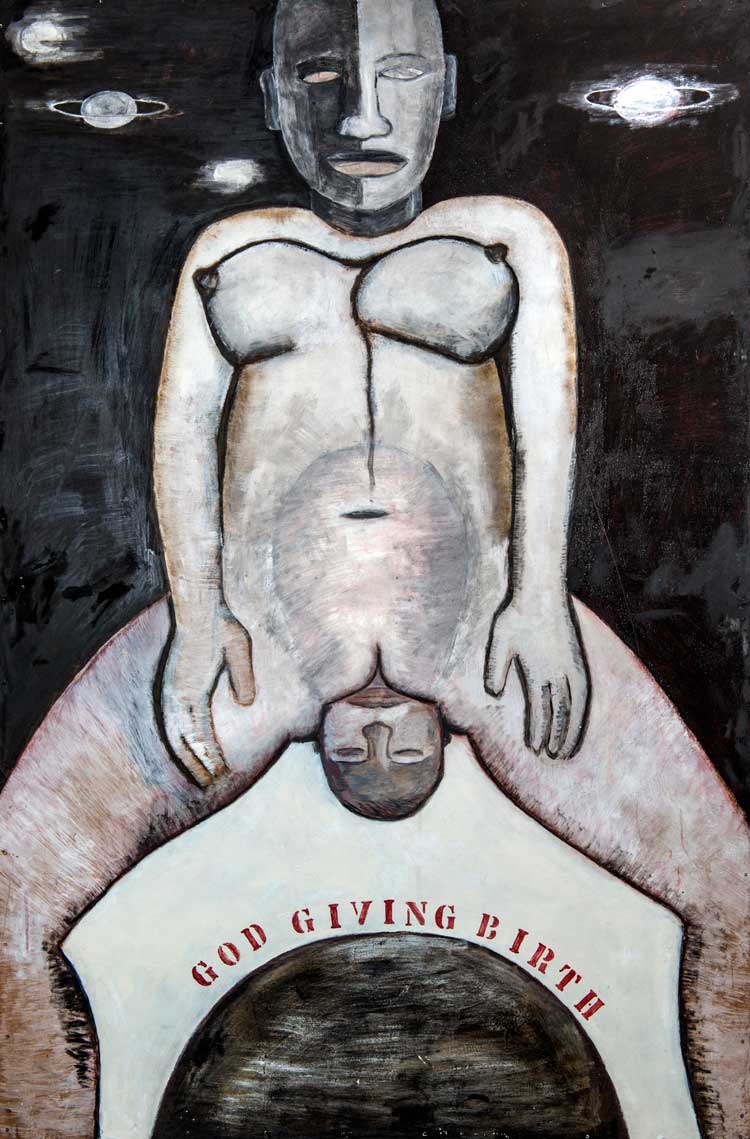
Monica Sjöö, God Giving Birth, 1968. Courtesy Museum Anna Nordlander. © Monica Sjöö Estate.
Every aspect of Sjöö’s life was entwined with her art. Nothing was separate. Her inquiry into ancient, matriarchal cultures was a lifelong search for knowledge and understanding that moulded her thinking and her art. In her art, writing and lectures, she used this well of knowledge to outline a different sort of future for humanity, one where spirituality is at the heart of political change. That spiritual conviction was entirely embedded within and around her politics and especially in relation to the women’s movement and environmental movements. Never one to sit on the sidelines, Sjöö always acted on her convictions. This include making art, something she believed was itself activism.
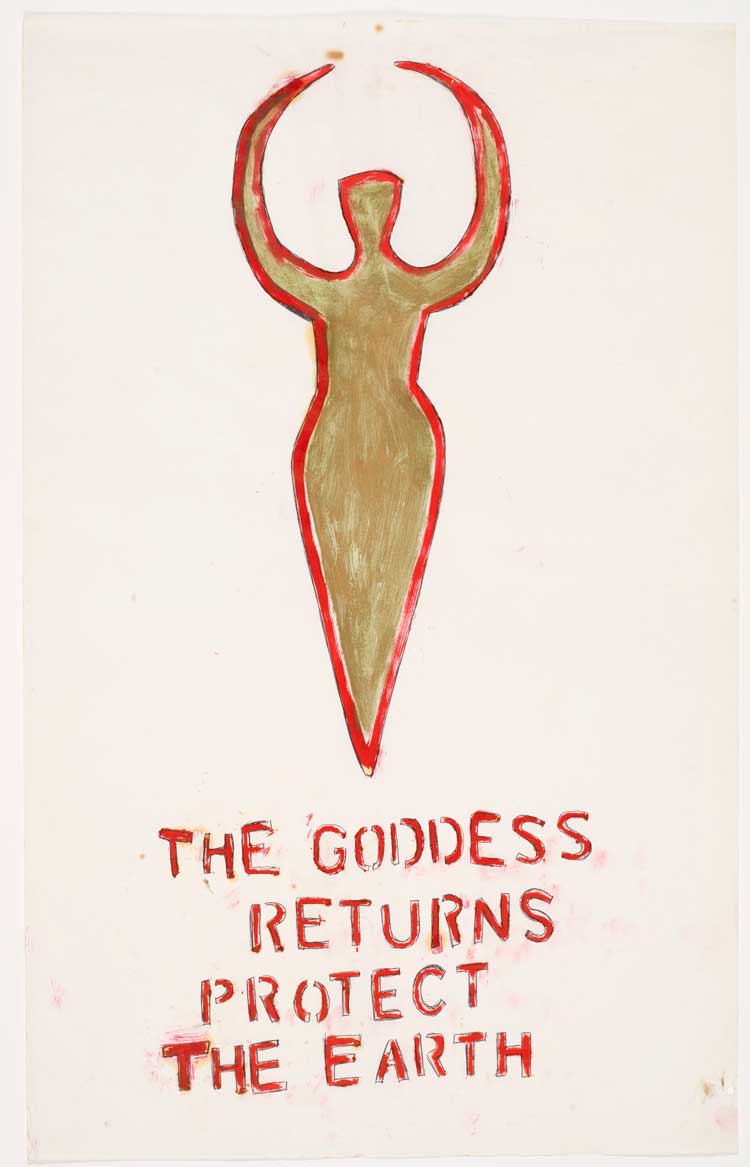
Monica Sjöö, The Goddess Returns to Protect the Earth, c1998/1999. Courtesy Monica Sjöö Estate and Alison Jacques, London. © Monica Sjöö Estate.
I never met Sjöö, but I did spend time in this exhibition talking with her daughter-in-law, Annie Johnston, and Sjöö’s friend Maggie Parks. From their accounts – and Sjöö’s personal history, writing and painting bear this out – she was a passionate, strong, principled individual. She noted the date and title of everything she ever made, knowing it was important work. She would have recognised the contemporary climate crisis and any number of conflicts across the globe as continuations of events and causes she protested against in her lifetime and ample cause for continued activism today. The spirit of this exhibition may have been forged by Sjöö in the 60s and onwards through her life, but its political urgency remains fresh and potent, while bringing the power of the Great Mother to a new generation of women.
• The exhibition will tour to Moderna Museet Malmö, Sweden, 23 March – 8 September 2024.